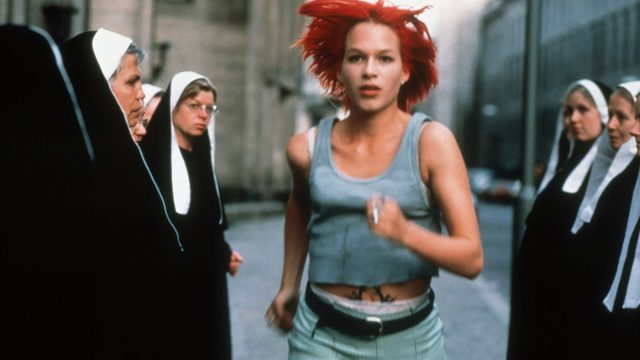Speed Through This Week’s Topics:
- classic thrillers
- how to criticize a movie
- political wrestling
- why stories suck!
Thanks to scb0212 and nikmarov for giving the FAR a second wind this week. Send articles throughout the week to ploughmanplods [at] gmail, post articles from the past week below for discussion, and Have a Happy Friday!
A. A. Dowd writes at Digital Trends about the still-propulsive thriller Speed, made so long ago Joss Whedon was brought on to delete one-liners:
Speed, which turns 30 today, arrived during a true arms race for Hollywood action cinema — a time when the explosions, the steroidal stars, and the budgets just kept getting bigger and bigger. It opened about a month before True Lies, the first movie ever to cost $100 million, and hence what you could then call the biggest action movie ever made. De Bont’s film wasn’t exactly a modest alternative: Its high-stakes, no-breaks plow through rush hour in Los Angeles was made to be witnessed loud and large. But the movie’s alchemy was different: While Sly and Arnold dealt mass death with a quip, Speed’s newly minted action hero, Keanu Reeves, spent most of his screen time trying to save lives, not take them. The movie, in turn, wanted to fry our nerves, not satiate our bloodlust.
And in other movie anniversaries, Steve Macfarlane interviews Tom Tykwer and Franka Potente about Run Lola Run for MUBI:
TYKWER: Before the Wall, yes. There are all these subconscious things that make it into a film: why you choose the messy techniques, the aesthetics that you choose… I think it’s all because of the place. The film is a reflection of the times in which it was made. It captures something of those days. But the thing about Berlin is, it’s a city that never stops being in progress, in transition, in chaos. Construction, deconstruction, reconstruction… It’s a mess, but it’s a beautiful mess because you never feel it will really come to a conclusion. You can never count on something still being there, so if you find it beautiful, go. Go now. Don’t say, “Cool, I’ll come back next year!” Because it might all be gone. There’s something quick and, you might say, “superficial,” about it, but instead of that word, I would say it’s alive. The film reflects that: I could be like this, but then again I could also be like this… But then, I could also be like this! Then you tell the story of the city, but it also gives the film an unpredictable energy.
The Yale Review‘s Annie Berke writes about the days when Siskel and Ebert ruled the film criticism landscape:
Siskel and Ebert also succeeded because they treated film criticism on TV as its own form. There had been TV film critics before them—most notably the Today show’s Judith Crist (who was so famously harsh that the director Otto Preminger dubbed her “Judas Crist”) and her dorky-dad successor, Gene Shalit. But Siskel and Ebert took the form to a new level. They learned to adapt their writing to the demands of television, crafting copy that was quick and to the point. By the 1980s, as they were segueing out of public television and into a broader, mainstream platform complete with commercial breaks, a typical review on the show would be only twenty sentences. Under those circumstances, it is a near-miracle that they still made time for banter alongside their distinct arguments about what film and film criticism should be.
For Public Books, Arvin Alaigh looks at professional wrestling’s creation of spaces that mirror and possibly foment political violence:
That professional wrestling can so seamlessly obfuscate fantasy and fact that fans are moved to violent reaction should not be surprising. Through kayfabe, wrestling can literalize and launder a political project. Freed from the potential of social reprisal or censure, its fans have permission to jeer, boo, and confront head-on the anxieties that fundamentally structure their worldview. The result is a sort of emotional transformation—and arguably a politicization—that re-entrenches the sense of precarity that undergirds a right-winger’s view of the world.
At Castalia, Sam Kahn writes about the tyranny imposed by stories:
Stories align with very deep structures in the human psyche and have fairly narrow, almost-quanifiable rules. They have a beginning, middle, and end, for instance. They have moments of crisis and end in resolution. Maybe most importantly, they exist in a very clear, cordoned-off timeframe — once a story ends, it ends, and it follows from there that a story has its own energy system, which can be optimized, so that everything in the story contributes to everything else like in some perfect, crisply-flowing machine. […] That school of thought is worthy of respect, of course, but I find it somehow lacking. Simply put, there is a great deal in life that doesn’t line up with the world as it is presented to us in stories. There is dead time, there is feeling lost, there is what I used to think of as the walking-aroundness of life, there are the cycles of sun-up, sun-down, of seasonal renewal, which have only a glancing resemblance to the beginning-middle-and-end of story structures. I felt this strongly in my own life when, very naively, as a teenager, I imagined that the books I read would give me some insight into how the world worked and then discovered in my 20s that that just didn’t really seem to be the case. There seemed to be whole swathes of existence — what it’s like to have a job, how money works, the meandering course of most relationships and friendships — that just somehow didn’t really register in even the very highly-regarded, ostensibly successful stories that I was coming across.


